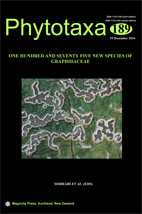Abstract
Two new genera and twelve new species of Graphidaceae are described from Puerto Rico. The two new genera, Borinquenotrema and Paratopeliopsis, are based on a combination of molecular sequence data and phenotype characters. Borinquenotrema, with the single new species B. soredicarpum, features rounded ascomata developing beneath and persistently covered with soralia and with an internal anatomy reminescent of Carbacanthographis; it is close to the tribe Ocellularieae. Paratopeliopsis, including the single new species P. caraibica, resembles a miniature Topeliopsis but differs in the distinctly farinose thallus and the small, brown ascospores; it is not closely related to the latter genus but belongs in tribe Thelotremateae. The other ten new species belong in the genera Acanthotrema, Clandestinotrema, Compositrema, Fissurina, Ocellularia, and Thalloloma. Acanthotrema alboisidiatum is closely related to A. brasilianum but differs in the short, white isidia resembling insect eggs. Clandestinotrema portoricense has a unique ascospore type with a longitudinal septum only in the proximal cell. Compositrema borinquense resembles a species of Stegobolus but belongs in Compositrema based on sequence data, and is characterized by ascomata with a unique columella composed of thick, irregularly radiating strands. The second new species in this genus, C. isidiofarinosum, differs by its ecorticate, farinose thallus with scattered, corticate isidia and by its small ascomata with inconspicuous columella. The three new species of Fissurina all have 3-septate ascospores and are otherwise characterized by an isidiate thallus and stellate, orange-yellow lirellae (F. aurantiacostellata), a verrucose thallus strongly encrusted with calcium oxalate crystals and white, irregularly branched lirellae (F. crystallifera), and myriotremoid ascomata arranged in short lines (F. monilifera). Ocellularia portoricensis belongs in the core group of Ocellularia and differs from O. cavata in the white medulla and the larger ascospores becoming brown, whereas O. vulcanisorediata produces prominent soralia and immersed ascomata with apically carbonized excipulum and columella and small, transversely septate, hyaline ascospores; it is closely related to O. conformalis. Finally, Thalloloma rubromarginatum resembles T. haemographum in the brownish lirellae with bright red margin but differs from that and other species in the corticate thallus and the norstictic acid chemistry. The new combination Ampliotrema rimosum (Hale) Mercado-Díaz, Lücking & Parnmen is also proposed. Considering the current biodiversity knowledge on this family, the high level of endemism observed in other groups of organisms in the island, and the relatively high number of Graphidaceae described, it is highly likely that at least some of these new taxa are endemic to the island. This view is further supported by the unique features of several of the new species, representing novel characters in the corresponding genera.

